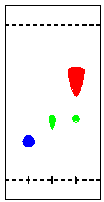
General Announcement (Please read!)
1. It has come to my attention that some students are not clear about certain policies in this course. There is no such policy in this lab course which discourages students from asking questions. The reason why you are here is to learn. This should also result in questions from the the student's side, which are welcome by the teaching assistants and the instructor. However, it is expected that the student comes prepared to the lab section in order to be able to complete the experiment in a timely fashion. The majority of the questions regarding the experiment (theory and practical issues) can be answered during lecture and office hours. A question also should demonstrate the student's ability to analyze the problem and be as specific as possible in his/her inquiry.
2. In the future, please do not study outside my office (YH3077E). My colleagues in the office suite try to get some work done, and the noise outside is rather disturbing i.e. cell phones, etc.
ATTN: answers to the below questions are due at the start of your lab period; these answers should be part of your pre-lab write-up.
1. Referring to the Aldol reaction carried out in the lab, answer the following questions. Show pertinent equations where appropriate.
a. Student A uses 95% ethanol as solvent for the reaction. What would he observe?
b. His neighbor does not reflux the mixture before adding the ethanolic potassium hydroxide solution. Which problem does this pose?
c. Student C obtained 0.300 g of the crude product. He places it in a 100 mL Erlenmeyer flask and then adds 20 mL of warm solvent. What would he observe?
d. Why is extensive boiling during the recrystallization in this reaction unwise?
e. Why is it important to allow the solution to cool down slowly during the recrystallization step?
2. A student isolates 2.40 g of a crude product Z that shows the following solubilities (in g/10 mL) in 95% ethanol, diethyl ether and toluene. The impurity to be removed is relatively non-polar.
| Temp (oC) |
DEE
|
EtOH | Toluene |
| 0 | 0.2 | 1.2 | 0.1 |
| 20 | 0.5 | 2.5 | 0.2 |
| 40 | 1.5 | 3.9 | 0.3 |
| 60 | XXX | 6.5 | 0.4 |
| 80 | XXX | 10 | 0.5 |
| 100 | XXX | XXX | 0.6 |
a. Which solvent should the student use for recrystallization? Rationalize your choice.
b. Assuming the recrystallization is carried out correctly, how much of the pure product would be recovered?
3. While running the following reaction
A + B --> C + D
a student acquires a TLC for his reaction mixture using a plate coated with silica and a mixture of dichloromethane and hexane (3:2) as eluent. He observes the following result

Note: Compound C is not UV-active. Lane 1 is compound A, lane 2 is compound B and lane 3 is the sample from the reaction mixture.
a. Determine the Rf-values for all compounds.
b. What can be said about the progress of the reaction?
c. His neighbor decides to use a solvent mixture diethyl ether and hexane (3:2) as eluent instead. Which changes would he observe?
d. Why is one of the spots in lane 3 so large? Which problem can this pose potentially?